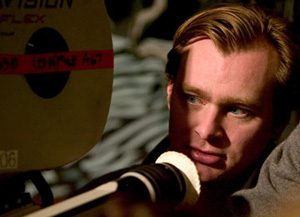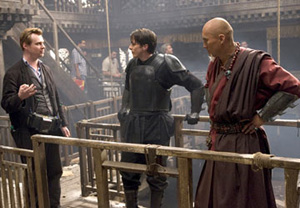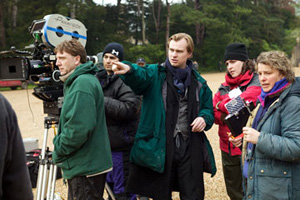 Next up we have writer/director Christopher Nolan, best known for his smaller and more psychological films, Memento and Insomnia. Nolan has displayed an undeniable talent for capturing real human drama and in the exploration of the thoughts and motivations of his often densely layered characters. That’s no different here in Batman Begins (especially in the first half). Nolan treads all new ground with the Dark Knight himself and shows audiences the core of Batman’s humanity, and more so, the reasons as to why he’s become the iconic figure that stands out from its comic book brethren today.
Next up we have writer/director Christopher Nolan, best known for his smaller and more psychological films, Memento and Insomnia. Nolan has displayed an undeniable talent for capturing real human drama and in the exploration of the thoughts and motivations of his often densely layered characters. That’s no different here in Batman Begins (especially in the first half). Nolan treads all new ground with the Dark Knight himself and shows audiences the core of Batman’s humanity, and more so, the reasons as to why he’s become the iconic figure that stands out from its comic book brethren today.
Q: Batman Begins seems darker than the previous film. Do you think kids will be into it?
Nolan: I think there has been this increasing misperception that kids will not respond to something because it’s also for adults. I think that often that tends to get underestimated.
Q: Do you want to do bigger movies after this one?
Nolan: To be honest, I really couldn’t do much bigger than this one. I would certainly love to do something on this scale again, because I enjoyed it. But I would also be interested to go back to something smaller. I think there are advantages to different scales of filmmaking. You wouldn’t want to do just one thing.
Q: This film seems to deal a lot with the underlying issues of what makes Bruce Wayne become Batman. How much of his anger is really under control by the end of this film?
Nolan: Well, I think when it’s harnessed, and that is a form of control, that doesn’t mean it’s not there and it doesn’t mean it’s suppressed it’s channeled and it’s harnessed. And that to me is what keeps him as a character frightening to his opponents and all of us to some extent.
Q: What was the creative mandate going in for a new audience?
Nolan: The creative mandate was really to do something fresh and original. And that was coming straight from the studio. And if it wasn’t, I wouldn’t have gotten involved with the project because it’s pretty rare to have an iconic figure that’s owned and controlled by a studio that’s asking you to do something different with it. That really was the mandate. For me, what that became was my desire to do something we hadn’t seen before, a superhero story told in a realistic fashion. And doesn’t step outside itself and acknowledge the form and the medium it’s coming from, but one in which the audience is just immersed in the reality that’s going on.
 Q: What was your inspiration for the look of Gotham City?
Q: What was your inspiration for the look of Gotham City?
Nolan: We tried not to be too specific. When Nathan Crowley, my production designer, started discussing the look of the film with me, we immediately rejected any reductive notions. The driving force was not to, "Okay, they’ve done an art deco city, we’ll do a modernist city," nothing like that. We wanted something that reflects the reality of a large modern city which is a tremendous variety of architecture. A tremendous variety of periods in which things were built. We wanted a history to the place as well as a contemporary feel. What we wound up doing, is that the way that we approached Gotham as an exaggeration of New York, an exaggeration of a modern American city was to look at interesting geographical features of different cities of the world. A lot from New York, some from Chicago, a lot from Tokyo because of elevated freeways and monorails. From Hong Kong we took the walled city of Kowloon [which] is the basis for The Narrows which is this kind of walled in slum. So what we really did was putting together the elements that let you exaggerate all the socio-economic factors that feed into Gotham as an exaggeration of the modern American city.
Q: Are you up for making any sequels?
Nolan: Well, I enjoyed making this film very much. So, I would be open to it. But I wouldn’t want to jump into it straight away.
Q: How hard was it to co-ordinate all the practical effects in the movie?
Nolan: The challenge wasn’t really to me, it was to the stunt co-coordinator and the physical effects guy. And they rode to this admirably. In a day and age when so much is done with computers they really rose to the opportunity. They really enjoyed the opportunity which is performing amazing feats and building amazing things that can actually work in the real world. To me, once I set that all in motion it was really just a question of filming it and trying to be disciplined about not listening to the little voices in your ear that says, "Well, you could do this with visual effects. You could leave this for now." You could move on and not [be] effective. I’m very glad we held to that discipline, because it meant in post production when we did get into our visual effects components we had all the right materials to make that stuff look great and not have to do too much of it. And we had the time to do what we did do. We had the time to perfect it, because we weren’t doing four to five times the number of shots we said we were going to do which is what happened on a lot of these films.
 Q: What is the next comic book character that you would like to tackle?
Q: What is the next comic book character that you would like to tackle?
Nolan: I don’t know what I want to do next. My brother is actually working on a screenplay that is based on a comic called The Exec that you know we’re quite excited about. But I really don’t know how I’ll end up choosing my next project; it just kinds of happens.
Q: What kind of approach did you take with the actors?
Nolan: My approach with actors is to try and give them whatever it is they need from me. Direction to me is about listening and responding and realizing how much they need to know from me and how much they have figured out for themselves, really. And this was a very, very talented bunch of actors and they were very specific in what they wanted to do. What was nice about that is that they were very relaxed with the notion that I had a lot of other things to worry about, because of the scale of the film. In the past with my films I’ve been able to concentrate very, very much with the performances of the actors. With this film there were all kinds of other things to take into consideration. But as very talented and generous actors, they allowed me to do that without feeling shortchanged. They seemed to accommodate that very easily.
Q: What was your visual agenda for the film and how much was discovered in the editing room?
Nolan: Well, you always discover a lot in the editing room. Particularly the action, because you have to over-shoot a lot and shoot an enormous amount of material because many of the sequences have to be discovered in the editing and manipulation of it. But for the rest of it, my shooting style was the same as it’s been on previous films. I don’t think there was any accommodation. [I think] one of the trickier things was having the guts to build colossal sets and not shoot them. To just shoot the scene the way I thought it should be shot. But everybody was okay with that. It worked out.
 Q: Can you talk a little about Katie Holmes and her appeal?
Q: Can you talk a little about Katie Holmes and her appeal?
Nolan: I think she’s got a wonderfully, warm and generous presence that’s very glamorous. Very girl next door at the same time. But she also has this maturity beyond her years which the character really needed. Because Rachel really is Bruce Wayne’s conscious in a sense. She has to stand for a couple of things. She has to be the life he might have had, what he lost, but she also has to be the voice of his conscious and keep him on his toes. And I think Katie did those things very well.
Q: Did you give Christian Bale direction on expression through his mask more?
Nolan: Yes, to a certain extent, but he was also very specific in what he wanted to do and he drew from a lot of certain influences that I agreed with in terms of the graphic novels. A lot of what he was able to turn into performance comes from that material.
Q: If you were to come
back for a sequel, have you given any though to the story? It seems
like the last scene sets things up for one.
Nolan:
Yes, it does but for me that was just a way to send the audience out
with a sense of possibility and sense of excitement about where this
character could go. I certainly share that sense and we’ve certainly
talked in vague terms about how you could follow on from this film
absolutely. But at the same time, it’s very important that this film
stand on its own.
Be British and brilliant on our message boards!